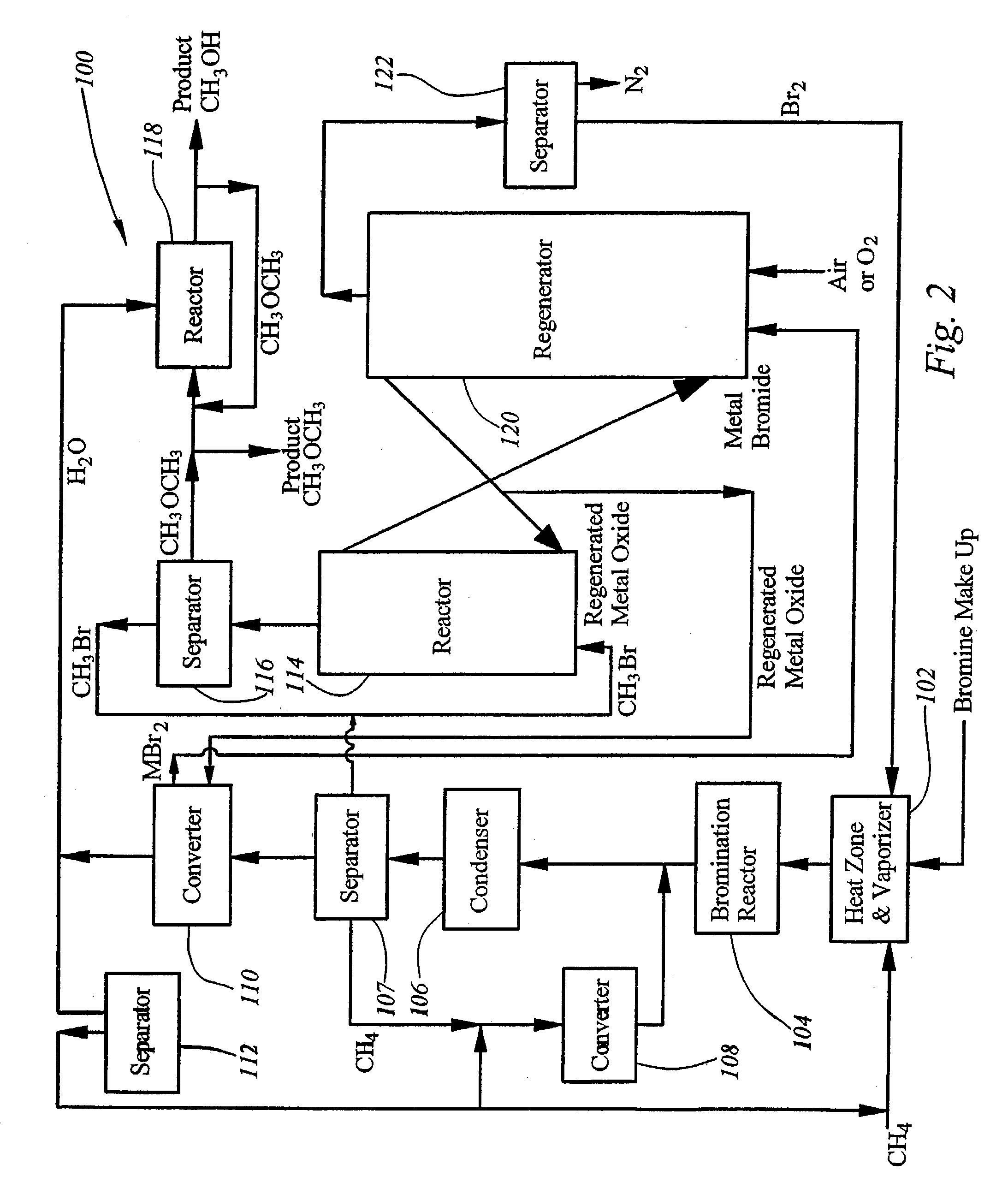Integrated process for synthesizing alcohols, ethers, aldehydes, and olefins from alkanes
a technology of alkanes and synthesis processes, applied in the field of alkanes synthesis of alcohols, ethers, aldehydes, and olefins, can solve the problems of affecting the synthesis of alkanes, so as to achieve less corrosion and improve safety.
- Summary
- Abstract
- Description
- Claims
- Application Information
AI Technical Summary
Benefits of technology
Problems solved by technology
Method used
Image
Examples
example 1
Reaction on M1
[0042]For all of the examples provided above the second stage of the process occurs as follows. After separation of the CH2Br2, CHBr3 and CBr4 products from the gas stream, the CH3Br, together with the HBr are passed into the next reactor, which contains M1 (50% CuO on ZrO2) and is maintained at 225° C. Flowing the reactant gases at 10 h−1 gives a 96% conversion of CH3Br+HBr to CH3OCH3 and H2O, or to CH3OH, or a mixture of CH3OH, CH3OCH3, and H2O, with 94% selectivity, the remaining product being CuBr2 / ZrO2 and 6% CO2. Dimethyl ether and water are converted into methanol if desired in a third reactor containing catalysts.
example 2
Zr Solution Preparation
[0043]Zr(OCH2CH2CH3)4 (70(w) % in isopropanol, 112.6 ml) was dissolved into acetic acid (275 ml) under stirring. After stirring for 10 minutes, the solution was diluted by water to make a total volume of 500 ml. A solution with a Zr concentration of 0.5M was obtained.
Preparation of M2
[0044]Cu(NO3)2 (0.5M, 7.200 ml) solution was added into BaBr2 (0.5M, 0.800 ml). A clear solution was obtained. To this solution, Zr solution (0.5M) as prepared above was added under stirring. After stirring a few seconds, a gel was obtained. The gel was dried at 110° C. for 4 hours, then heated to 500° C. within 6 hours, and kept at 500° C. for 4 hours. M2 was obtained.
[0045]The metal oxide mixture was tested at a CH3Br flow rate of 1.0 ml / minute at 230° C. In the first half hour, the average CH3Br conversion was 65%, and the average dimethyl ether selectivity was 90.5%.
Preparation of M3
[0046]Cu(NO3)2 (0.5M, 40.000 ml) solution was added into Zr solution (0.5M, 30.000 ml as prepar...
example
Part A. Alkane Bromination Reaction
Propane Bromination Reaction
[0079]A mixture of propane (6.0 ml / minute) and bromine (Br2 0.30 ml / hour) was passed into a reactor (glass tube ID 0.38″, heating zone length 4″), which was heated to 270° C. The effluent was analyzed by GC / MS. 100% bromine conversion with 88.9% 2-bromopropane selectivity and 11.1% 1-bromopropane selectivity were obtained.
[0080]This reaction can also be a catalysis reaction. The catalysts are compounds of Ti, Zr, Hf, V, Nb, Ta, Cr, Mo, W, Mn, Re, Fe, Ru, Co, Rh, Ir, Ni, Pd, Pt, Cu, Ag, Au, Zn, Cd, B. Al, Ga, In, Tl, Si, Ge, Sn,. Pb, P, Sb, Bi, S, Cl, Br, F, Sc, Y,. Mg, Ca, Sr, Ba, Na, Li, K, O, La, Ce, Pr, Nd, Sm, Eu, Gd, Tb, Er, Yb, Lu, and Cs or mixtures of such compounds. The reaction can be carried out at a temperature range from about −10° C. to about 600° C. The reaction pressure can be from about 1 to about 200 atm. The reaction mixture can have a ratio of propane to bromine from 0.1 to 100.
Bromination of Isobutan...
PUM
| Property | Measurement | Unit |
|---|---|---|
| temperature | aaaaa | aaaaa |
| temperature | aaaaa | aaaaa |
| pressure | aaaaa | aaaaa |
Abstract
Description
Claims
Application Information
 Login to View More
Login to View More - R&D
- Intellectual Property
- Life Sciences
- Materials
- Tech Scout
- Unparalleled Data Quality
- Higher Quality Content
- 60% Fewer Hallucinations
Browse by: Latest US Patents, China's latest patents, Technical Efficacy Thesaurus, Application Domain, Technology Topic, Popular Technical Reports.
© 2025 PatSnap. All rights reserved.Legal|Privacy policy|Modern Slavery Act Transparency Statement|Sitemap|About US| Contact US: help@patsnap.com



